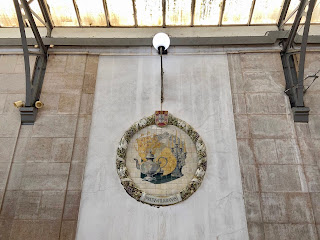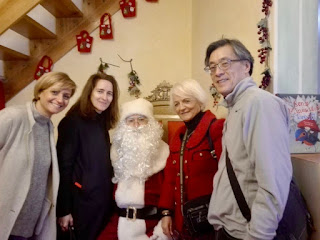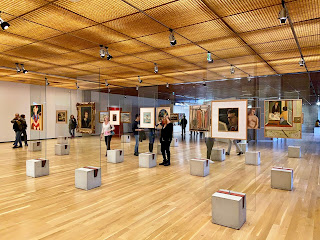Despite the mild disappointment with Wonderland Lisboa, we are headed out to Sintra with our friend Marta to see the Christmas lights and shop in the outdoor market. I'm thinking that this storybook town might be the perfect setting for a holiday experience, and can imagine the palaces and woods that we visited last summer sparkling. Our train today is from Rossio, a station that we've explored on the outside, but not the inside. This station has a quite grand and clean train shed, with some very nice tile "wreaths" celebrating Portuguese commerce.
We arrive in Portela, one station short of Sintra station, meet Marta's sister Cati, and take a sort walk to the town center. The music is piped all around the street and follows us all around town. It's the same "rocking Christmas" music that you might hear anywhere, which is both reassuring and annoying – I guess it's just part of there season now.
We have a tasty vegetarian lunch at A Praça, a unique cafeteria-style restaurant connected to the Museu de História Natural de Sintra. From the entry area, you can peer into the Museum and see a Braseodactylus (pterodactyl) skeleton. After lunch, we cross into the "valley" of the Rio Porto, which becomes suddenly misty and humid. We walk past the the sculpture gallery of Museu Anjos Texeira, and through a grove or trumpet lilies (we are told these are poisonous) to the other side and a wonderful view back to the Palacio. Up the steps, past more sculptures along the walled walk, and we find ourselves at the lacy white gatehouse to the Reino do Natal (Kingdom of Christmas).
The Reino is set in the Parque da Liberdade. It is a series of theatrical vignettes and encounters; I suspect the drama departments of the local high schools are responsible for much of this. But kids are definitely "in the spirit" and the families and school groups walking the trails are truly enjoying it. The Parque is a series of wide and winding paths within a lush botanical garden, with little cal de sacs where the players play: Dormitório dos Duendes (Houses of the Elves), Bosque do Gigante (Giant's Woods), and Casa do Pai Natal (Father Christmas' House).
Our walk back down is through the Ávores de Natal (Christmas Trees), Ajudantes do Pai Natal (Father Christmas' Helpers), and Aldeia dos Bonecos de Neve (Snowmen's Village). We high-five the costumed snowman there, and pass group after group of giddy children, their faces painted with reindeer antlers and red noses. By the time we depart, the sun is setting and the lights are on all around the city.
I recall feeling somewhat cynical about the artificial storybook nature of Sintra, but as background for a Christmas village, it's on another level. But we are all smiles after being among the amazing old trees and old castles, and viewing the lights in and across the valleys, with the wreath on the City Hall and the big tree at the Library. We finish with a bag of roasted chestnuts as we merrily stroll past the vendors, their jewelry blankets and trinket stands along the walled sidewalks, on the way back to the train.








































